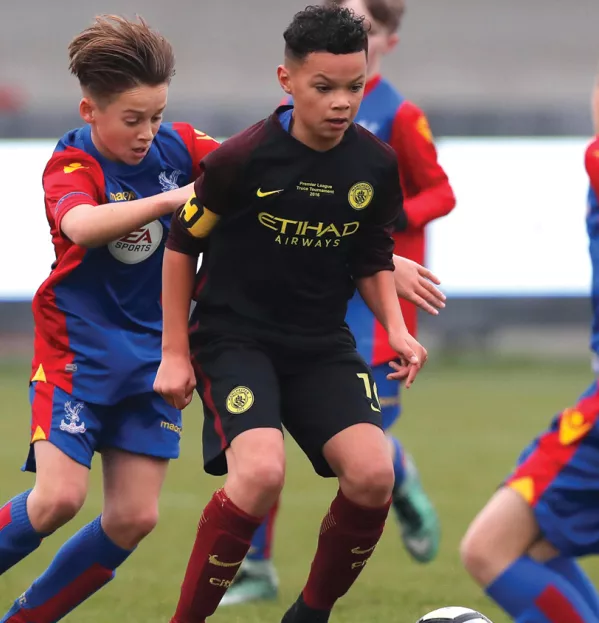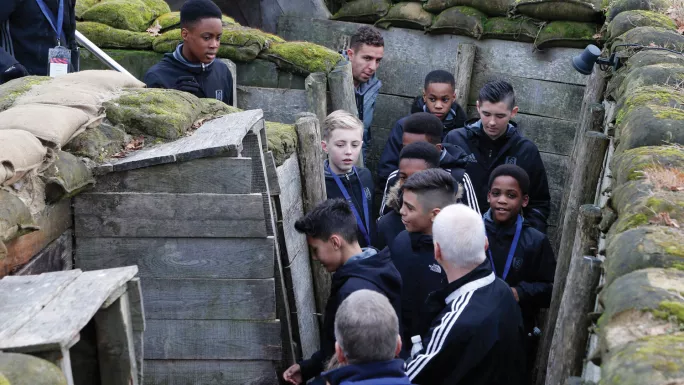‘They fought for us so we can play football today’

Strewn with corpses and churned up by shell blasts, the “football pitches” that sprung up in no man’s land on the battlefields of the First World War in December 1914 were a far cry from romantic notions of the brief ceasefires of Christmas that year.
For those Tommies who, in the spirit of the festive season, briefly laid down their weapons to take on the enemy in a kickaround, vicious swirls of barbed wire would have served as touchlines and tin cans were most likely used as footballs amid the mud and stench of war.
The fact that the “Christmas Truce” is so far removed from modern-day football has inspired those behind a unique education project that forges emotional connections between some of Europe’s top young players and the soldiers who took part in the legendary matches more than 100 years ago. Every year, under-12 teams from across the continent travel to Belgium to play in a tournament organised by England’s Premier League, commemorating the unofficial ceasefire.
Education is a crucial part of the programme and, before a football is kicked, the children spend a day touring battlefield sites and memorials such as Tyne Cot Cemetery, where the lives of nearly 12,000 British and Commonwealth soldiers are marked by row upon row of immaculate white headstones. Andy Caton, a physio for the youth teams at Crystal Palace, said that the tour “takes them out of their comfort zone and [they] start to see a different perspective”.
Impromptu ceasefire
Among the most poignant moments for Mr Caton’s group of players was learning that the youngest British soldier in the Great War was the same age as themselves: Sidney Lewis enlisted in the East Surrey Regiment aged 12 and, at 13, fought in the Battle of the Somme.
And one memorial in particular resonates with the young footballers: an understated monument to the Christmas Truce - a life-sized sculpture of a football on a plinth - stands over a box crammed with footballs, shirts and scarves from teams around the world.
The unofficial truce that broke out along parts of the Western Front just before Christmas Day in 1914 involved British and German soldiers setting down their weapons in impromptu displays of festive goodwill. They sang carols, hoisted Christmas trees atop their dugouts and met in no man’s land to exchange cigarettes and souvenirs.
But this brief respite from the carnage of the First World War is remembered today largely because of sporadic games of football. Historians say that nothing like an organised, full-blown match took place anywhere - brief kickabouts with bully-beef tins replacing footballs were more likely - yet the story of football between the trenches has endured.
In the present day, at the site of the momentous Battle of Passchendaele, the young footballers witnessed an actor dressed as a soldier of the Gordon Highlanders speaking of the agony of legs cut to ribbons by shards of ice forming on soldiers’ kilts. Such evocative images puncture the romanticism of the truce by showing how, most of the time, the theatre of war was a million miles away from the world of football.
“You have drills on the football pitch, but this is different,” the actor told the Crystal Palace boys as he demonstrated bayonet practice. “You’re going to take someone’s life with a piece of metal…death and destruction - that’s what we’re here for.”
Many professional footballers died in the First World War. Edinburgh team Heart of Midlothian - which has sent players to a previous tournament in Belgium - suffered catastrophic losses: 16 players from the club signed up and seven first-teamers died.

Spirit of friendship
Another casualty was Joe Bulcock, who played for Crystal Palace for five years but died in 1918. As part of their tour, the club’s under-12s visited Private Bulcock’s grave.
One modern-day player, Josh Nyame, said: “It was quite upsetting, but I was grateful at the same time because he kind of fought for us in a way, so we can play this day.”
Teammate Richard Faakey added: “It meant a lot, because when you play for a club, you don’t really think of war - war is one of the last things on your mind. All you want to do is play football, so I really praise him for stopping and fighting for the country. It shows that he’s got a lot of character.”
The players saw a mock-up of the trenches and heard that many men drowned in the mud of no man’s land, and that soldiers held urine-drenched socks over their faces to try to protect themselves during chlorine gas attacks.
After the somewhat oppressive atmosphere of the battlefield, the players relished returning to the football pitch the next day, and exchanged presents with opponents in the spirit of international friendship.
As the young Crystal Palace players prepared to attend the nightly memorial ceremony at the Menin Gate in Ypres, they were feeling reflective. One, Rory Edwards, summed up the changing mood of the group: “We’re not just here to play football, we’re here to commemorate people that died.”
You need a Tes subscription to read this article
Subscribe now to read this article and get other subscriber-only content:
- Unlimited access to all Tes magazine content
- Exclusive subscriber-only stories
- Award-winning email newsletters
Already a subscriber? Log in
You need a subscription to read this article
Subscribe now to read this article and get other subscriber-only content, including:
- Unlimited access to all Tes magazine content
- Exclusive subscriber-only stories
- Award-winning email newsletters